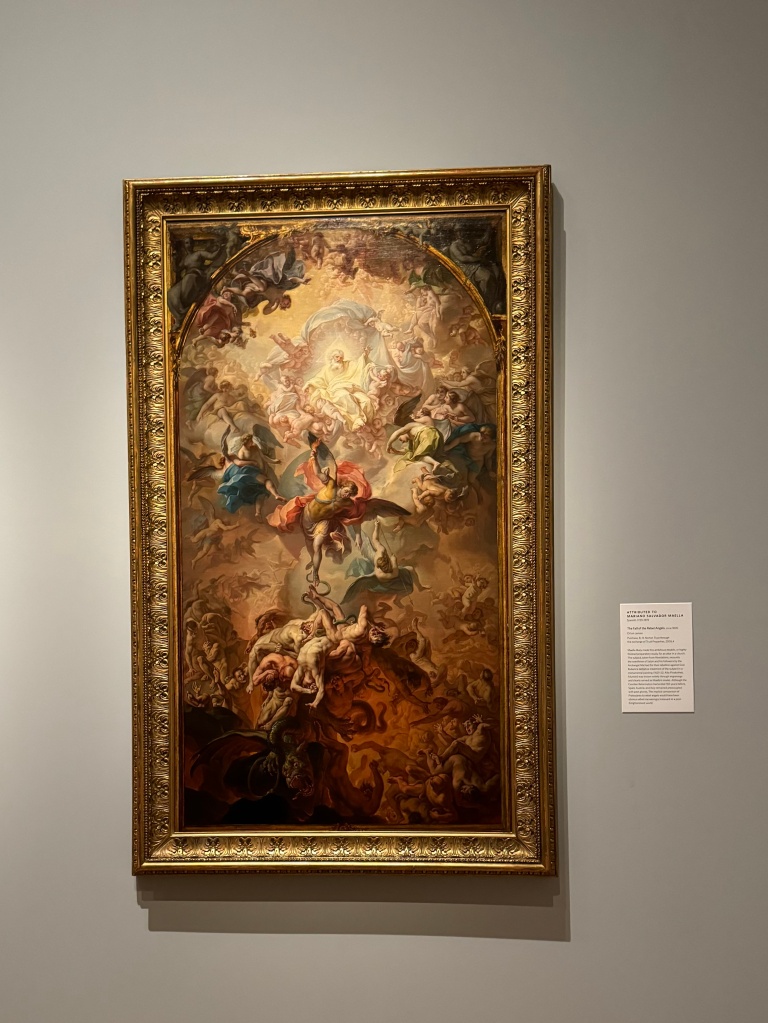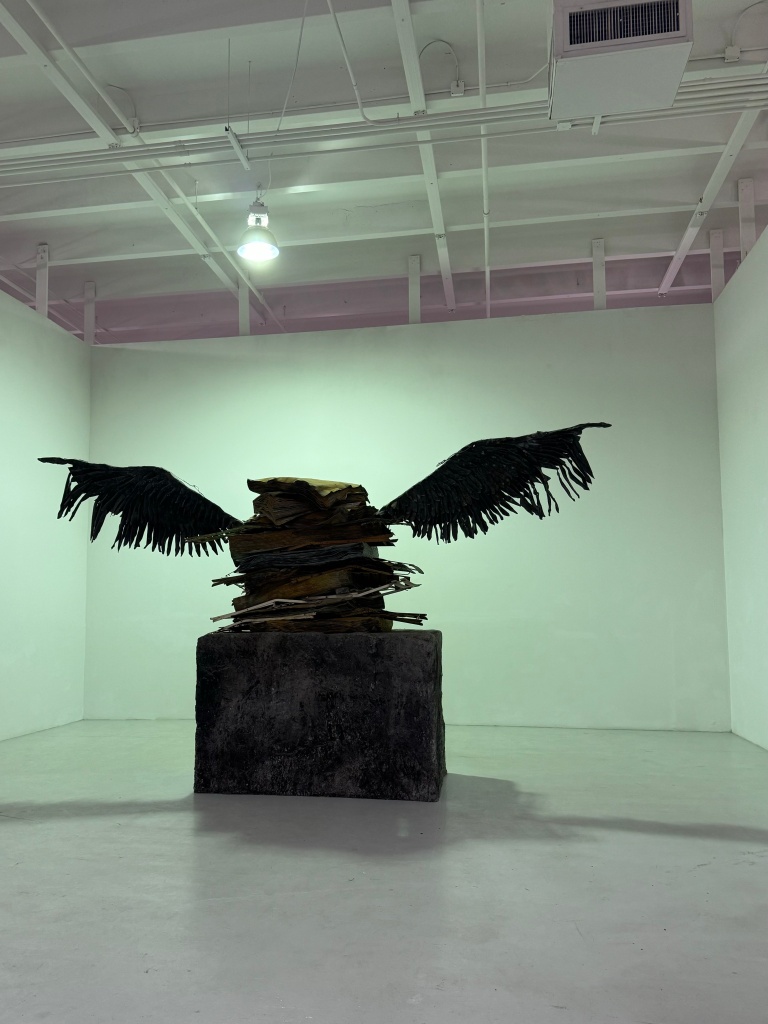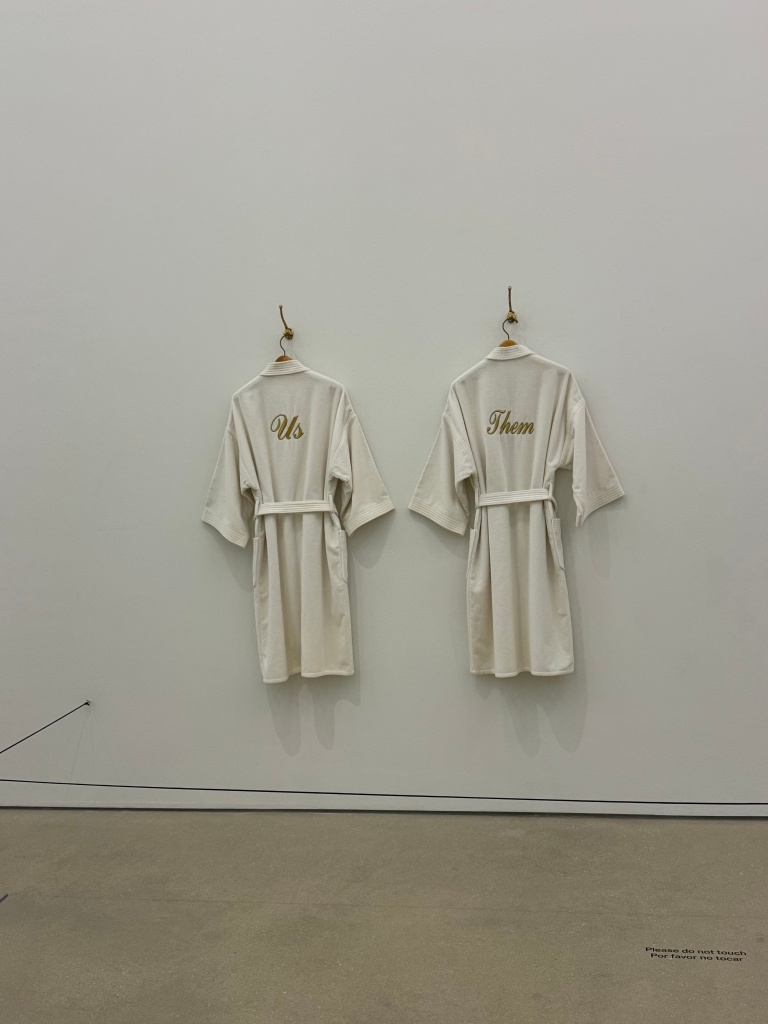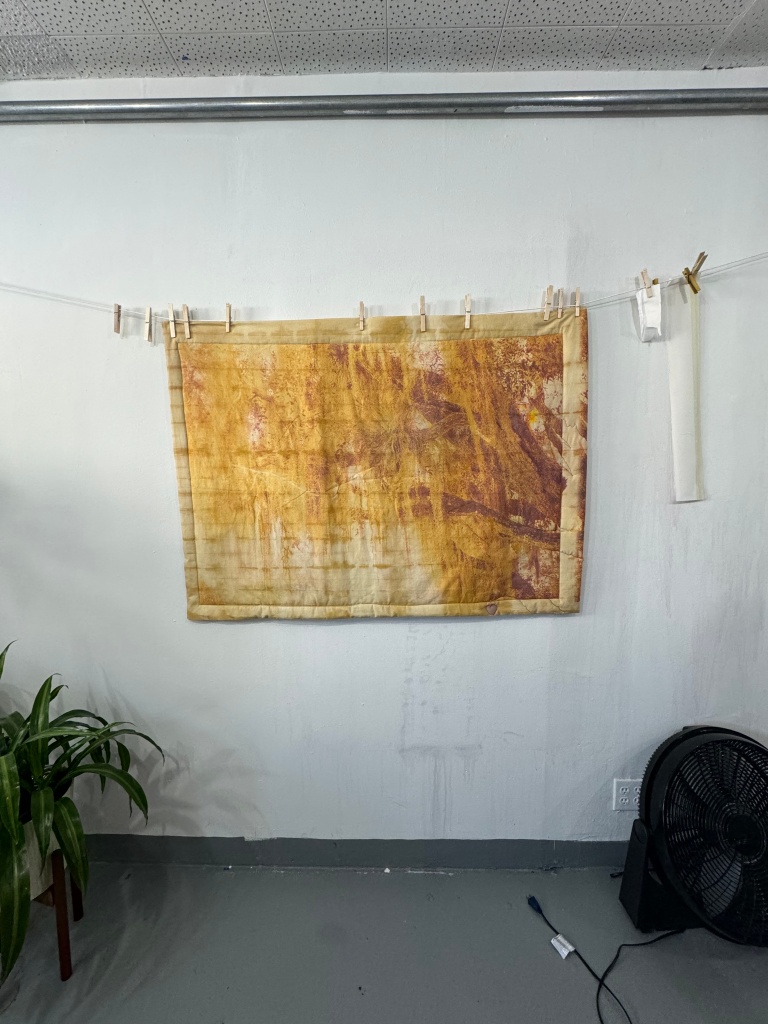
Hi! My name is Elianyi Pimentel. I am currently a sophomore at Florida International University double majoring in psychology and natural and applied sciences on a pre- pa track. I was born in Dominican Republic but migrated to Miami when I was five years old. Though I have no significant art background, I am looking forward to learning!
ART ENCOUNTER AS TEXT
By Elianyi Pimentel of FIU on January 18th, 2024, Miami, Florida

Photo by Elianyi Pimentel, CC by 4.0
Though I was not born in Miami, I have spent the majority of my life within its borders. Growing up I remember my parents, teachers, and peers being impressed with my artwork. However, as soon as I started middle school, I was no longer in an art program which caused me to stop drawing. Consequently, I stopped caring much for art and have regretted not seeking it out, through some form or another, for so many years since. Especially considering how art rich Miami is. Even when you are not actively seeking it out, whether its graffiti or murals, the art seems to find you. I think I began to become more aware of this after witnessing firsthand just how quickly Wynwood was transformed into the Design District it is today from the unassuming, warehouse ridden community it used to be. (Pasols) My dad was a truck driver around the time this change was taking place, and I would accompany him on his routes. Throughout the years, I began to notice how Wynwood in particular was not as desolate as it used to be.
When I was in elementary school, I remember taking various field trips to different museums throughout Miami. Though I don’t remember being touched by any one piece in particular, I remember thinking that the exhibits we were visiting were just so impoverished that they could not afford a van Gogh. That was the only way my prepubescent mind could explain the unrelatedness of what I would see on these trips to what I was being shown in class. I hope I can say that now I am slightly less dim and can appreciate contemporary art more. According to What is Contemporary Art? By Terry Smith, Contemporary art is “postmodern art” or in other words any art that is being made currently. (Smith) This definition is very general, and the book spends the rest of its pages trying to explain what it means by this. However, it is a functional enough definition to explain why Miami is an epicenter for contemporary art. Miami is a densely populated city with a mixture of different cultures on every block. It would make sense to assume that the art scene would be vast, powerful, and dynamic to keep up with the times.
I am most looking forward to going to the Norton Museum of Art and the Rubell Museum. I don’t know much about either of these spots, but they were spoken about highly on the first day of class. Though I am excited to see what each museum contains individually I am also excited to see how they compare to one another. I chose this course because I feel as though I am going to get a more in-depth perspective on the artwork through the class than if I were to go by myself or with friends. As was mentioned in the introductory class, Art is such a big part of history that if you don’t know how to carry a conversation around it you are missing out on many a conversation.
References
Pasols, Aaliyah. “Gentrification Complete: Will Wynwood’s Progress Be Its Downfall?” Miami New Times, Miami New Times, 7 Oct. 2021, http://www.miaminewtimes.com/music/history-wynwood-miami-gentrification-13066720.
Smith, Terry. What Is Contemporary Art? University of Chicago Press, 2009.
Norton as Text
By Elianyi Pimentel of FIU on January 28th, 2024, Miami, Florida

The Fall of the Roman Angels pictured by Elianyi Pimentel, CC by 4.0
Walking into the Norton Museum of Art I was expecting to see an impressive collection of Western European artwork. Partially because it was implied that this would be the case in lecture and partially because when I was approaching the neighborhood in where the museum is located, it occurred to me that the art selection would need to cater to a particular group of people in order for the museum to stay in business. My thoughts were put into words when professor Bailly clarified that the vast majority of the museum goers were people of western European descent. After lecture, I am glad to say I was not disappointed in my initial assumption. On the contrary, I was quite taken away by the artwork in the western European gallery upstairs.
The initial pieces in the Western European gallery were all religious. Most of them contained the virgin Mary and baby Jesus. As the paintings evolved from early renaissance to late renaissance the holy figures within the paintings became more realistic. This was a big no-no for some Catholic’s at the time because they believed that making the depictions of the Virgin Mary and Jesus too realistic would be borderline sacrilegious. I grew up catholic, so I have heard the phrase “don’t worship or serve idols of any kind” within a religious context many a time. However, I did not realize that technically paintings could be seen as idols. It was really interesting seeing how these artworks that are such a big part of history came from a loophole. Nonetheless, it is even more insane when you consider that some of these people were holding on to the point that as long as the paintings are fantastical, they were not sinning. What metrics were they using for sanctifying artworks as okay versus demonic?
It was news to me that Islamic and Judaic religions saw any direct representation of holy figures as being sacrilegious. This revelation shaped the way I looked at the renaissance paintings because in my head I was able to better understand in what environment these paintings were being done. It was funny how slowly but surely the artists became more comfortable with drawing women’s breast just for the sake of drawing women’s breast but never forgot to include a baby breastfeeding in the painting for good measure. Then came the Baroque period which completely exaggerated all things religious and fantastical. In contrast to the renaissance, Baroque artists did not seem to care much about being conservative in their artistic replications of nature. Quite the opposite, Baroque artists such as Rubens seemed to want to get as real a portrait as possible. Surprisingly enough, by this time the Catholic church seemed to have warmed up to the idea of not only endorsing realistic religious paintings but also beautifully grand depictions of holy figures. Not only did the baroque period include a rebirth in the Catholic community’s approach to art. I noticed that in this time period there were more paintings that were not religious in nature.
Margulies/Bakehouse as Text
By Elianyi Pimentel of FIU on February 10th, 2024, Miami, Florida

Wings of Desire pictured by Elianyi Pimentel, CC by 4.0
I was a harsh critic of contemporary art before visiting the Margulies Collection at the Warehouse. I use the term “critic” lightly because I was never educated enough on the concept of contemporary art to form a valid assessment on any one piece. With that said, I can earnestly say my views have done a complete 180 after having visited the Margulies Collection at the Warehouse. I never thought I could be touched by a contemporary painting. Not to discredit Campbell’s work but it takes me too long to figure out the meaning behind his pieces to even appreciate any raw emotional reaction. However, upon seeing pieces like 21 Backs by Magdalena Abakanowicz and Secret of the Ferns by Kiefer I was immediately hit by what felt like a rock in my chest. I did not have to know any background on the artist or their intentions to be transported to a different time. It just so happens both of the examples listed above reminded me of the holocaust immediately. I later learned that Abakanowicz’s piece was not intended to be linked to any one particular event. She states that it touches on “the human condition in general.” I thought this was an interesting choose of words because to me that corner of the warehouse just screamed “suffering.” It reminded me of the quote “to live is to suffer.” That was just what I assumed from their positioning. Professor Bailly then tells the class to appreciate the top of the sculptures. Then it is revealed that all these bodies are hollow. That added another layer to the piece. Not to mention the positioning of them within a space in where you would almost have to intrude of the sculpture space to see that they were in fact hollow bodies.
My favorite contemporary piece was the aged superhero piece. It was comparable to a super upbeat song with sinister lyrics. At first it seemed so bright. All the costumes were naturally saturated and even the lighting illuminated the space in a cheery way. But then you really look at the elders and it is just heartbreaking. They do not look happy at all. They look like they are wasting away. They are just complacent with what is inevitable… death. I think aging by itself is scary but coming to terms with decaying is a much harder pill to swallow.
After Margulies, we went to Bakehouse. I did not know that a place like Bakehouse existed. The experience of visiting a place which houses so many artists as they work made it seem as though art really is everywhere. Adler Guerrier talked on sacred geometry and how it can be utilized as a language to give life to a painting. To me, this completely changes how I viewed his works. At first, they seemed pretty but almost infantile. I say almost because that is what I would have thought if I just saw one. However, seeing so many paintings with the same stencils made it seem much more mature and strategic but it wasn’t until he explained his view that it became fully intelligent and beyond me.
Art Wynwood as Text
By Elianyi Pimentel of FIU on March 3rd, 2024, Miami, Florida

Ojitos Para Que Te Tengo pictured by Elianyi Pimentel, CC by 4.0
I thought that by now these trips would start to become repetitive in the way that the art is displayed. However, the opposite has become true. Every place that we have visited thus far has offered a unique angle on how to approach the world of art. Our most recent trip was to Art Wynwood. I was too busy worrying about how parking would be to really have any anticipation of what the venue would have to offer. Once I arrived, I was shocked at how small the space was. I assumed it would be held in an open-air kind of set-up and that it would take up a large plot of land next to bayside. Instead, the whole fair was around the size of a medium-sized department store.
What surprised me most about this experience was learning about the relationship between the artists, exhibitors, and galleries. The first exhibit we visited was hosted by the Cernuda Arte gallery. In this showcase, we were introduced to the works of various Cuban artists. The first one being Wilfredo Lam. Wilfredo Lam was an afro-Cuban artist who focused on expressing the afro-Cuban experience through a surrealist lens. We learned that there is a horse-like figure which reappears in many of his works that is meant to represent the Cuban mother. When I first heard this, I thought the choice of animal implied that Lam was trying to attach a negative connotation to these women when, on the contrary, he is trying to convey an image of strength in hopes of inspiring admiration towards them instead. Though I had never heard of him before, it is inspiring to know that Lam is widely known with works being displayed in such institutions as the MoMa.
I remember being particularly attracted to a painting within the Cernuda Arte exhibit which showed a green and gloomy lakeside landscape. What most attracted me was how serene it seemed. The parallel lines that divided the tree from the shore, the shore from the water, and the water from the shadows were all perfectly aligned with one another. It looked perfect but not too perfect. I remember one of my classmates mentioned that it seemed like a picture. In truth, it did. Now, imagine my surprise when I found out that the painting was a product of the surrealist movement. It was only after this revelation when it became exceedingly obvious that such a view was not likely natural. After researching Sanchez further, it is interesting how some of his works are very obviously surrealist while others, such as the one that was being displayed in the fair, are harder to pinpoint. Sanchez is still alive today making him a contemporary artist. His works vary greatly in selling price from a couple hundred to upwards of one million. One of his biggest selling points is that landscapes seem to have been blacklisted from the contemporary artists’ social sphere. It is rarely seen in newer works which in turn gives Sanchez leverage at auctions and or fairs such as Art Wynwood.
Rubell/Emerson Dorsch as Text
By Elianyi Pimentel of FIU on March 17th, 2024, Miami, Florida

Family pictured by Elianyi Pimentel, CC by 4.0
This week we visited the Rubell Museum in Allapattah. This museum holds a wide range of contemporary art. Something I particularly appreciated was the layout of the museum. It was essentially one long hallway with different rooms that jutted out to the side. Each room held either one installation, various installations by the same artist, or different works by different artists which all follow a similar theme. My favorite room was the one that held works by Karon and Noah Davis. Not only were the pieces in the room complimentary to one another, finding out that the two of them were married made the synchrony of work all the more impactful. I thought that the flowers placed by Karon Davis under one of Noah Davis’ paintings could count as art even if it may not be regarded as such by the museum or even Karon herself.
To me, Karon’s sculpture titled Family was arguably one of the most eye-catching works so far in the semester. It reminded me of the movie The Lion, the Witch, and the Wardrobe. In it three beings with predominantly African features are shaped in piercing white plaster. They are each sporting antlers as they embrace one another. The antlers are supposed to show that, like deer, the family in the sculpture are being hunted. The little boy is sporting a backpack which implies he is going to school. This tiny detail adds layers of meaning. For one, now on top of being hunted as a unit the child will have to leave his parents. His life is essentially in the hands of strangers who have their own agenda. There could even be a hunter among said strangers.
This piece is clearly a commentary on the disproportional violence against African American families in America. I think it is very successful in carrying out its message for two reasons. The first one being that the artwork is good. It is large, eye-catching, and in your face. All qualities which I think are necessary when making a statement because without them who will care enough to listen. The second reason why I think this piece deserves all the props is because it shows a seen which most people can relate to. Most parents know the fear of dropping their kids off for the first time. Most kids can remember the fear of being without their parents for the first time. In other words this artwork displays a universal sadness that is amplified by the fact that the family in the scene is a minority.
We also visited Emerson Dorsch which is an art gallery in Miami. Immediately I noticed that unlike the places we visited prior, these pieces did not have labels with the name of the artist/work. I learned that galleries are not really profitable and their main focus is to break even every year. I do not know why bit something about that was really refreshing. Sometimes art seems like it’s a money game. It is but regardless the lack of profit makes the whole ordeal seem a bit more authentic.
PAMM as Text
By Elianyi Pimentel of FIU on March 31st, 2024, Miami, Florida

Public Enemy by Gary Simmons pictured by Elianyi Pimentel, CC by 4.0
This week we toured the Perez Art Museum Miami. This contemporary art museum, also known as PAMM, located at a spits distance from the Frost Museum was nothing like what I expected. After touring so many contemporary museums I was sure the next one would have nothing new to offer. And just like every week, I was glad to be proven wrong once again. Throughout the tour, I kept questioning whether the same person had created all the artworks shown or if “Gary Simmons” was a collector instead of an artist. I thought maybe he was someone who had curated the show through years of looking for the perfect pieces to tell his storyline. Our wonderful guide, T. Elliot Mansa, did repeatedly mention”the artist” which would imply one person. However, to me the greatest pieces were so diverse and yet so well done that I found it hard that each work could be the result of one person’s genius.
The whole show dealt with race but what I liked is that it didn’t feel preachy. It just sowed you the proof. I wouldn’t say I am a history buff. Quite the opposite, but when I entered each room I could feel the implications almost instantly. None so potently, as the eyewitness identification piece with the figure-less shoes and the classroom. The witness background is the first thing you see when you turn from the poster collage wall to the following room. By now, T. Elliot has highlighted how so far the body is implied in Gary Simmons’ work. The concert banners and poster wall are meant to invoke a selfie and thus a body will evidently be a part of the usefulness of the art. With this said, we turn and see large golden sneaker pairs in front of a witness background and the intent becomes evidently clear.
I don’t know if outside of the context of the show I would have thought of random men from all walks of life filling in those shoes. What I do know is after hearing about the hip hop scene’s not-so-subtle rebuttal to racism in the 90’s. I was already in the headspace to assume that the piece in question was commenting on the disproportionate incarceration rates targeted towards black men in America. I thought it was a brilliant way to do so. Because by having the bodies missing he is playing on what everybody knows is happening and yet wants to act isn’t. I think it would evoke self-reflection in most people, especially in those who still try to deny America has an inherent race issue.
The next room in my opinion was the most jarring. First you see the boards and desks and everything is jolly and fine and then you turn and see mini- KKK uniforms and suddenly you find your jaw dropping. It’s insane yet true. This room was not referring to a dystopian world where kids are trained to be racist. It’s pointing out the obvious. Racism is taught and bred. I particularly liked when T. Elliot pointed out that there is white chalk on a white board implying whatever is being taught is pointless. I also liked how the narrow boards imply narrow minds.
Wolfsonian as Text
By Elianyi Pimentel of FIU on April 11th, 2024, Miami, Florida

Diana Eusebio pictured by Elianyi Pimentel, CC by 4.0
This week we explored the art scene in Miami Beach with visits to Oolite Arts and the Wolfsonian. Oolite Arts is an art studio which is currently housing around 14 in house studio residents. Last Friday, we got the honor of meeting many of these artists who were nice enough to show us their work. My group started the tour off by listening to Onajide Shabaka. He is an elder gentlemen who has cemented his place in the art sphere through photography. Near the end of his lecture, I was hit with a wave of nostalgia when he showed us some leaf prints he had done during a lecture out in the everglades. I remembered doing something similar in elementary school. To me, it was refreshing seeing that such a seemingly simple technique could be enjoyed by both kids in their first art class as well as bonafide professionals in the field.
We then went into Diana Eusebio’s studio. I don’t think it would be too farfetched to assume that Diana’s studio was by far the favorite amongst everybody in my group. Besides her being a naturally charismatic individual, her work was unlike anything we have seen before. I remember walking into her studio and immediately feeling giddy upon seeing the quilt hanging from the wall as well as the lone sewing machine on the table. My mom used to sew, and I had recently considered taking up some classes to see if I could find a new hobby in sewing. My curiosity only spiked after Diana started explaining what exactly it is, she does. She not only sews and prints and paints but she also makes her own dyes. She explained that she grows various plants which she then uses to dye her clothes. For the red dye she crushes these bugs which are the same kind used to give pigment in anything containing red 40.
We then visited Carrington Ware who was the first mainly digital artist in the tour. Her studio was the least occupied which made sense considering most of her work was being done on the computer. Then, we went into Lee Pivnik’s studio. His studio in my opinion was the coolest. I have never seen such futuristic pieces come from one individual. Even the way it was set up with the bookshelf in the back made it seem like he was really juicing every inch of space for all its worth which I appreciated. Lastly, we stopped to pass by Alejandra Moros’ studio. I was also giddy walking into her studio because I arrived late to class, and she was the girl in the beginning who led me to the rest of the class. I thought her paintings were super cool and very obviously hers. By that I mean her style of painting seemed to be the same in every frame. Every work was soft and rounded. She mentioned she had a show coming up in September and that this has been the longest she had ever taken to prepare for a show which has been nearly a year. I asked how many pieces she was planning on making and her answer surprised me. She didn’t know. I really liked her answer because it shows she really is trying to find pieces that complement each other enough to make a show she is proud of.
Art Reflection as Text

Mark Coetzee Pictured by Elianyi Pimentel, CC by 4.0
After taking this course, I can say that my understanding of the Miami art culture has greatly expanded. In the first week of class, when asked what I knew about the Miami art culture my mind automatically raced to the obvious; Art Basel and Wynwood. When asked about the same subject now, my mind goes to the everchanging graffiti that lines the highway entrances, the different art complexes that house dozens of artists with varied concentrations in one large building, and the galleries that run because of the people who believe in the culture so much that they work non-lucrative careers just to keep it alive.
I know that Miami is an epicenter for contemporary art. This is because it is an overpopulated melting pot. Everything gravitates towards it, especially art which is in everything. Though new and exciting seems to be the focus of the Miami art scene, there is still a large amount of art from past era’s being shown and circulated throughout the city limits. Now, I know that contemporary art refers to any art being made currently. Someone in one of the lectures brought out a good point that put things into perspective for me. They asked what the art that is being produced in this time period be called once it’s over because it won’t qualify as contemporary anymore. Professor Bailly clarified that most of the past artistic periods like the Renaissance or the Expressionist movement did not acquire their name until it ended.
Before I said I was in this class to become more well versed on art because I felt like it was a topic discussed amongst a large portion of the population and I did not want to be left out of the conversation. I feel like my objective has been completed. I definitely know more about the art world now than I did going in. Additionally, I have come out of this course with a newfound interest in art as a whole. What I like most about what I have learned is that art seems to be one of those things that you could dedicate your whole life to learning and still only brush the surface of all there is to know. Learning this has made it easier to understand why it seems to always be a topic of discussion. You can always learn something from whomever you’re talking to.
Before, the image art would create in my mind is one similar to the works created by the artists of the renaissance. Now, that image couldn’t be farther from what I think of. I think of street art, I think of the artists we met in the studio houses, I think of the art fairs. In short, I tend to think of the environment which fosters the art more so than I do any particular work when asked that specific question. Quite frankly, I think the environment from which an artwork is released is one of the most important factors that goes into its creation.